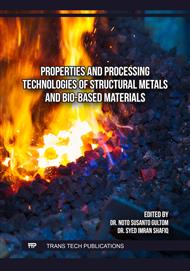[1]
Da S, M LF, Chsner AO, Adams RD. Handbook of Adhesion Technology. 2011.
Google Scholar
[2]
Structural Adhesives and NVH Selector Guide. Www.henkelna.com/loctite 2015. http://na.henkel-adhesives.com/us/content_data/330380_LT4809_10458_ Structural_Bro_ LR_v11_1.pdf (accessed December 13, 2015).
Google Scholar
[3]
Nogata F, Takahashi H. Intelligent functionally graded material: bamboo. Composites Engineering 1995; 5:743–751.
DOI: 10.1016/0961-9526(95)00037-n
Google Scholar
[4]
Raphael C. Variable-adhesive bonded joints. Applied Polymer Symposia 1966;3:99–108.
Google Scholar
[5]
Pires I, Quintino L, Durodola J, Beevers. Performance of bi-adhesive bonded aluminum lap joints. International Journal of Adhesion and Adhesives 2003;23:215–23.
DOI: 10.1016/s0143-7496(03)00024-1
Google Scholar
[6]
Zhao B, Lu ZH, Lu YN. Two-dimensional analytical solution of elastic stresses for balanced single-lap joints. International Journal of Adhesion and Adhesives 2014:115–26.
DOI: 10.1016/j.ijadhadh.2013.12.026
Google Scholar
[7]
Zeng Q, Sun CT. Fatigue performance of a bonded wavy composite lap joint. Fatigue & Fracture of Engineering Materials 2004:413–22.
DOI: 10.1111/j.1460-2695.2004.00761.x
Google Scholar
[8]
Sancaktar E, Kumar S. Selective use of rubber toughening to optimize lap-joint strength. Journal of Adhesion Science and Technology 2000:1265–96.
DOI: 10.1163/156856100742195
Google Scholar
[9]
Fitton MD, Broughton JG. Variable modulus adhesive : an approach to optimized joint performance. International Journal of Adhesion and Adhesives 2005;25:329–36.
DOI: 10.1016/j.ijadhadh.2004.08.002
Google Scholar
[10]
Da Silva LFM, Adams RD. Joint strength predictions for adhesive joints to be used over a wide temperature range. International Journal of Adhesion & Adhesives 2007:362–79.
DOI: 10.1016/j.ijadhadh.2006.09.007
Google Scholar
[11]
Temiz S. Application of bi-adhesive in double-strap joints subjected bending. Journal of Adhesion Science and Technology 2006:1547–60.
DOI: 10.1163/156856106778884262
Google Scholar
[12]
Halil O, Ozkan O. Comparative Evaluation of Numerical and Analytical Solutions to the Biadhesive Single-Lap Joint. Mathematical Problems in Engineering 2016;2014:16.
DOI: 10.1155/2014/852872
Google Scholar
[13]
Kong FR, You M, Zheng, Ling X. Three-Dimensional Finite Element Analysis of the Stress Distribution in Bi-Adhesive Bonded Joints. The Journal of Adhesion 2008:105–24.
DOI: 10.1080/00218460801952791
Google Scholar
[14]
International Stainless Steel Forum. Www.worldstainless.org 2016. http://www.worldstainless.org/ Files/issf/non-image files/PDF/Euro_Inox/Tables _TechnicalProperties_EN.pdf (accessed January 15, 2016).
Google Scholar
[15]
Manufacturer data sheet of Resinova Company. Resinova 2015. http://www.resinova.com/.
Google Scholar
[16]
ISO 15166-2, Adhesives — Methods of Preparing Bulk Specimens. Part 2: Elevated-temperature Curing One-part Systems. 2000.
DOI: 10.3403/02418863
Google Scholar
[17]
Kadioglu F, Adams RD. Flexible adhesives for automotive application under impact loading. International Journal of Adhesion & Adhesives 2015:73–8.
DOI: 10.1016/j.ijadhadh.2014.08.001
Google Scholar
[18]
Silva D, M LF, Dillard DA, Blackman B. Testing Adhesive Joints. Weinheim, Germany: Wiley-VCH Verlag & Co. KGaA, Boschstr. 12, 69469; 2012.
Google Scholar
[19]
ISO 527-2, Plastics - Determination of Tensile Properties. Part 2: Test Conditions for Moulding and Extrusion of Plastics (1993). 1993.
DOI: 10.3403/30216860
Google Scholar
[20]
Kadioglu F, Adams RD. Tensile stress-strain behaviour of a structural bonding tape 2002: 179-95.
Google Scholar
[21]
Her SC. Stress analysis of adhesively-bonded lap joints. Composite Structure 1999:673–8.
DOI: 10.1016/s0263-8223(00)00052-0
Google Scholar
[22]
Zhao B. Stress Analysis of Mixed-modulus Single-lap Adhesive Bonded Joints. International Conference on Mechanical Engineering and Mechanics, Wuxi, China: 2008, p.2019–24.
Google Scholar
[23]
Karachalios EF, Adams RD, Lucas, Da Silva LFM. Single lap joints loaded in tension with high strength steel adherends. International Journal of Adhesion & Adhesives 2013;43:81–5.
DOI: 10.1016/j.ijadhadh.2013.01.016
Google Scholar
[24]
Karachalios EF, Adams RD, Da Silva LFM. Single lap joints loaded in tension with ductile steel adherends. International Journal of Adhesion & Adhesives 2013;43:96–108.
DOI: 10.1016/j.ijadhadh.2013.01.017
Google Scholar
[25]
Da Silva LFM, Ochsner A, Adams RD, editors. Heidelberg: Springer; 2011.
Google Scholar



